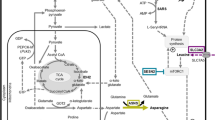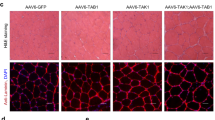Abstract
Localized synthesis of insulin-like growth factors (IGFs) has been broadly implicated in skeletal muscle growth, hypertrophy and regeneration1. Virally delivered IGF-1 genes induce local skeletal muscle hypertrophy and attenuate age-related skeletal muscle atrophy, restoring and improving muscle mass and strength in mice2. Here we show that the molecular pathways underlying the hypertrophic action of IGF-1 in skeletal muscle are similar to those responsible for cardiac hypertrophy. Transfected IGF-1 gene expression in postmitotic skeletal myocytes activates calcineurin-mediated calcium signalling by inducing calcineurin transcripts and nuclear localization of calcineurin protein. Expression of activated calcineurin mimics the effects of IGF-1, whereas expression of a dominant-negative calcineurin mutant or addition of cyclosporin, a calcineurin inhibitor, represses myocyte differentiation and hypertrophy. Either IGF-1 or activated calcineurin induces expression of the transcription factor GATA-2, which accumulates in a subset of myocyte nuclei, where it associates with calcineurin and a specific dephosphorylated isoform of the transcription factor NF-ATc1. Thus, IGF-1 induces calcineurin-mediated signalling and activation of GATA-2, a marker of skeletal muscle hypertrophy, which cooperates with selected NF-ATc isoforms to activate gene expression programs.
This is a preview of subscription content, access via your institution
Access options
Subscribe to this journal
Receive 51 print issues and online access
$199.00 per year
only $3.90 per issue
Buy this article
- Purchase on Springer Link
- Instant access to full article PDF
Prices may be subject to local taxes which are calculated during checkout




Similar content being viewed by others
References
Florini, J., Ewton, D. & Magri, K. Hormones, growth factors, and myogenic differentiation. Annu. Rev. Physiol. 53, 201– 216 (1991).
Barton-Davis, E., Shoturma, D. I., Musaro, A., Rosenthal, N. & Sweeney, H. L. Viral mediated expression of IGF-I blocks the aging-related loss of skeletal muscle function. Proc. Natl Acad. Sci. USA 95, 15603 ( 1998).
Shimatsu, A. & Rotwein, P. Mosaic evolution of the insulin-like growth factors: organization, sequence, and expression of the rat insulin-like growth factor I gene. J. Biol. Chem. 262, 7894–7900 (1987).
Musaro, A. & Rosenthal, N. Maturation of the myogenic program is induced by post-mitotic expression of IGF-I. Mol. Cell. Biol. 19, 3115–3124 ( 1999).
Chin, E. et al. Acalcineurin-dependent transcriptional pathway controls skeletal muscle fiber type. Genes Dev. 12, 2499 –2509 (1998).
Abbot, K., Friday, B. B., Thaloor, D., Murphy, T. J. & Pavlath, G. K. Activation and cellular localization of the cyclosporine A-sensitive transcription factor NF-AT in skeletal muscle cells. Mol. Biol. Cell 9, 2905– 2916 (1998).
Molkentin, J. et al. Acalcineurin-dependent transcriptional pathway for cardiac hypertrophy. Cell 93, 215– 228 (1998).
Crabtree, G. Generic signals and specific outcomes: signaling through Ca2+, calcineurin and NF-AT. Cell 96, 611 –614 (1999).
Kincaid, R. L. et al. Cloning and characterization of molecular isoforms of the catalytic subunit of calcineurin using nonisotopic methods. J. Biol. Chem. 265, 11312–11319 (1990).
Manalan, A. & Klee, C. Activation of calcineurin by limited proteolysis. Proc. Natl Acad. Sci. USA 80, 4291–4295 (1983).
Muramatsu, T. & Kincaid, R. L. Inhibition of NF-AT signal transduction events by dominant-negative form of calcineurin. Biochem. Biophys. Res. Commun. 218, 466–472 (1996).
Semsarian, C. et al. Skeletal muscle hypertrophy is mediated by a Ca2+-dependent calcineurin-dependent signalling pathway. Nature 400, 576–581 (1999).
Gruver, C. L., DeMayo, F., Goldstein, M. A. & Means, A. R. Targeted developmental overexpression of calmodulin induces proliferative and hypertrophic growth of cardiomyocytes in transgenic mice. Endocrinology 133, 376–388 (1993).
Wang, Z., Messi, M. L., Renganathan, M. & Delbono, O. Insulin-like growth factor-I enhances rat skeletal muscle charge movement and L-type Ca2+ channel gene expression. J. Physiol. 516, 331–341 (1999).
Bruton, J., Katz, A. & Westerblad, H. Insulin increases near-membrane but not global Ca2+ in isolated skeletal muscle. Proc. Natl Acad. Sci. USA 96, 3281–3286 (1999).
Molkentin, J. D., Lin, Q., Duncan, S. a. & Olson, E. N. Requirement of the transcriptional factor GATA4 for heart tube formation and ventral morphogenesis. Genes Dev. 11, 1061– 1072 (1997).
Hogan, P. G. & Rao, A. Modification by nucle export? Nature 398, 200–201 ( 1999).
de la Pompa, J. L. et al. Role of the NF-ATc transcription factor in morphogenesis of cardiac valves and septum. Nature 392, 182–186 (1998).
Ranger, A. M. et al. The transcription factor NF-ATc is essential for cardiac valve formation. Nature 392, 186– 190 (1998).
Wilson, C. M., Mitsumoto, Y., Maher, F. & Klip, A. Regulation of cell surface GLUT1, GLUT3, and GLUT4 insulin and IGF-1 in L6 myotubes. FEBS Lett. 10, 19–22 (1995).
Mitsumoto, Y., Downey, G. P. & Klip, A. Stimulation of glucose transport in L6 muscle cells by long-term intermittent stretch-relaxation. FEBS Lett. 301, 94–98 (1992).
Thai, M. V., Guruswamy, S., Cao, K. T., Pessin, J. E. & Olson, A. L. Myocyte enhancer factor 2 (MEF2)-binding site is required for GLUT4 gene expression in transgenic mice. Regulation of MEF2 DNA binding activity in insulin-deficient diabetes. J. Biol. Chem. 273, 14285–14292 (1998).
Florini, J. R., Ewton, D. Z. & Magri, K. A. Insulin-like growth factor-1 stimulates terminal myogenic differentiation by induction of myogenin gene expression. Mol. Endocrinol. 5, 718–724 (1991).
Engert, J., Berglund, E. B. & Rosenthal, N. Proliferation precedes differentiation in IGF-I stimulated myogenesis. J. Cell Biol. 135, 431– 440 (1996).
Nadal-Ginard, B. Commitment, fusion and biochemical differentiation of a myogenic cell line in the absence of DNA synthesis. Cell 15, 855–864 (1996).
Yaffe, D. Retention of differentiation potentialities during prolonged cultivation of myogenic cells. Proc. Natl Acad. Sci. USA 61, 477–483 (1968).
Loh, C. et al. Calcineurin binds the transcription factor NFAT1 and reversibly regulates its activity. J. Biol. Chem. 271, 10884–10891 (1996).
Northrop, J. P. et al. NF-AT components define a family of transcription factors targeted in T-cell activation. Nature 369, 497–502 (1994).
Dolmetsch, R. E., Lewis, R. S., Goodnow, C. C. & Healy, J. I. Differential activation of transcription factors induced by Ca2+ response amplitude and duration. Nature 368, 855–858 (1997).
Clipstone, N. A., Fiorentino, D. F. & Crabtree, G. R. Molecular analysis of the interaction of calcineurin with drug–immunophilin complexes. J. Biol. Chem. 269, 26431–26437 (1994).
Acknowledgements
We thank L. Sweeney, F. McKeon, C. Marks, and members of the Rosenthal laboratory for helpful discussion; A. Rao and G. Crabtree for advice and gifts of NF-AT antibodies; M. McGrew, C.Semsarian and R. Graham for sharing unpublished data; and J. Florini for his original concept and continued insights into the properties of IGF. The study was supported by grants to N.R. from the NIA and NASA, to A.M. from the MDA, and to E.N.O. from the NIH. F.N. was supported by an NIH postdoctoral fellowship.
Author information
Authors and Affiliations
Rights and permissions
About this article
Cite this article
Musarò, A., McCullagh, K., Naya, F. et al. IGF-1 induces skeletal myocyte hypertrophy through calcineurin in association with GATA-2 and NF-ATc1. Nature 400, 581–585 (1999). https://doi.org/10.1038/23060
Received:
Accepted:
Issue Date:
DOI: https://doi.org/10.1038/23060
This article is cited by
-
Motor neurons and endothelial cells additively promote development and fusion of human iPSC-derived skeletal myocytes
Skeletal Muscle (2024)
-
Advantage of ostarine over raloxifene and their combined treatments for muscle of estrogen-deficient rats
Journal of Endocrinological Investigation (2023)
-
Association of Insulin-like Growth Factor 1 Concentrations with Risk for and Prognosis of Amyotrophic Lateral Sclerosis – Results from the ALS Registry Swabia
Scientific Reports (2020)
-
Regulation of muscle growth and regeneration by the immune system
Nature Reviews Immunology (2017)
-
Muscle injuries and strategies for improving their repair
Journal of Experimental Orthopaedics (2016)
Comments
By submitting a comment you agree to abide by our Terms and Community Guidelines. If you find something abusive or that does not comply with our terms or guidelines please flag it as inappropriate.



